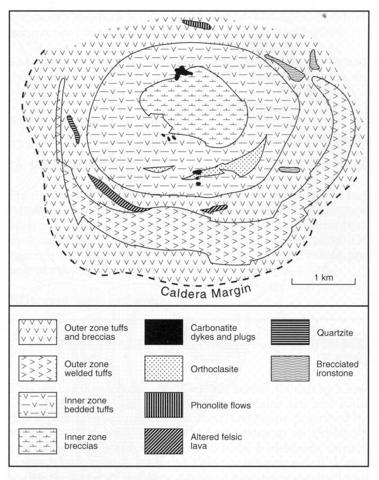stripes
Kruidfontein is a circular, 5 km diameter, deeply eroded carbonatitic volcanic complex consisting principally of pyroclastic rocks. The rocks have a concentric distribution giving an annular drainage pattern with the outermost mountainous ridge breached in three places. The complex can be divided into a central 2 km-diameter zone and an outer 1 km broad ring which Clarke and Le Bas (1990) consider to have been generated by caldera collapse, greater throw on the inner ring fault resulting in the preservation of at least 400 m of tuffs beneath the central zone, as indicated by drilling. Rocks of the central zone are essentially carbonatitic bedded tuffs, whereas the outer ring consists mainly of bedded silicate tuffs and breccias. Rocks of the outer ring form a series of overlapping arcs that are divided by Clarke into tuffs and breccias and welded tuffs (Clarke and Le Bas, 1990) and by Verwoerd (1967) into older and younger pyroclastic breccias and ignimbrite. Subsidiary flows of trachyte, phonolite, rhyolite and other lavas have been distinguished on field evidence and there are some areas of basement rocks protruding through the volcanics. Identification of all these rocks is difficult because of later thermal and mineralization events. The breccias and tuffs generally grade into each other and consist principally of rounded to angular tuff-sized fragments but with occasional larger blocks, perhaps 30 cm or more across, in a dense matrix. The fragments consist of trachytic, phonolitic, rhyolitic and sovitic rocks, which may be dense or vesicular, banded ironstone, quartzite, dolomite, schist and altered basic rocks, as well as crystals of feldspar, quartz, chlorite and opaque phases. There has been extensive replacement by quartz, carbonate and fluorite. Fragments of phonolitic pumice in these rocks have been investigated in detail by Clarke and Le Bas (1990) who show that there has been intense potassium metasomatism, while one glassy fragment proved to consist of alternating silicate and carbonate bands which were interpreted as representing two immiscible liquids that had been mixed mechanically. The ignimbritic rocks are thoroughly altered but pumice fragments are still recognisable. The main component of the central zone is a brown-weathering carbonate rock, referred to by Verwoerd (1967) as metabeforsite, which is a variably massive or bedded rock interpreted as an altered carbonate tuff. Along the northern margin the lowermost beds are metasovites. Irregular veins and some dykes of carbonatite occur in the central zone and Clarke (Clarke and Le Bas, 1990) mapped an arc of orthoclasites. The bedded metabeforsites display fragmentary and oolitic structures and consist of ankerite, intimately intergrown with alkali feldspar, chlorite, accessory fluorite, apatite, anatase and occasional quartz and calcite. The massive metabeforsite is mineralogically similar but contains a plethora of angular inclusions of lava and syenite. In the metasovites calcite is the dominant carbonate with abundant K-feldspar, fluorite again ubiquitous and barite present as scattered crystals and in veinlets. Fluorite-rich sovite dykes and almost pure fluorite veins are described by Verwoerd (1967) who also discusses at some length the geological history of the volcano. Chemical analyses of some of the rock types will be found in Fockema (1949). There are numerous mineral analyses and many analyses of carbonatites, with trace elements, including full suites of REE data, and C and O isotope data in Clarke et al. (1994), and electron microprobe analyses of pumice fragments in Clarke and Le Bas (1990). Au, Mn and Y enrichment in weathered carbonatitic pyroclastic rocks is described by Pirajno et al. (1995).
CLARKE, L.B. and LE BAS, M.J. 1990. Magma mixing and metasomatic reaction in silicate-carbonate liquids at the Kruidfontein carbonatitic volcanic complex, Transvaal. Mineralogical Magazine, 54: 450-56.CLARKE, L.B., LE BAS, M.J. and SPIRO, B. 1994 Rare earth, trace element and stable isotope fractionation of carbonatites at Kruidfontein, Transvaal, S. Africa. Proceedings of the 5th International Kimberlite Conference. CPRM, Brasilia. Volume 1. Kimberlite, related rocks and mantle xenoliths. 236-51.FOCKEMA, R.A.P. 1949. An occurrence of alkaline and acid lavas and volcanic breccias on the farm Kruidfontein 147, Rustenburg district. Transactions of the Geological Society of South Africa, 52: 205-29.PIRAJNO, F., BUTT, C.R.M. and WINTER, E. 1995. Gold enrichment in weathered carbonatite pyroclastics of the Kruidfontein volcanic complex, South Africa. South African Journal of Geology, 98: 319-25.VERWOERD, W.J. 1967. The carbonatites of South Africa and South West Africa. Geological Survey of South Africa, Handbook, 6: 1-452

